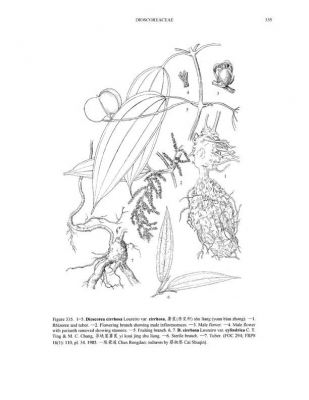Dioscorea cirrhosa
Lour.
Dioscoreaceae
Dioscorea angusta R.Knuth
Dioscorea bonnetii A.Chev.
Dioscorea camphorifolia Uline ex R.Knuth
Dioscorea intempestiva Prain & Burkill
Dioscorea matsudae Hayata
Dioscorea rhipogonoides Oliv.
Common Name: Dyeing Yam
General Information
Dioscorea cirrhosa is a dioecious, perennial plant producing annual, climbing stems about 10 metres long from a tuberous rhizome[
303- Title
- World Agroforesty Centre
- Publication
-
- Author
-
- Website
- http://www.worldagroforestry.org/
- Publisher
-
- Year
- 0
- ISBN
-
- Description
- An excellent online database of a huge range of trees giving very good information on each plant - its uses, ecology, identity, propagation, pests etc.
]. These stems scramble over the ground, or twine into the surrounding vegetation[
]. The stems twine to the right[
303- Title
- World Agroforesty Centre
- Publication
-
- Author
-
- Website
- http://www.worldagroforestry.org/
- Publisher
-
- Year
- 0
- ISBN
-
- Description
- An excellent online database of a huge range of trees giving very good information on each plant - its uses, ecology, identity, propagation, pests etc.
].
Formerly traded internationally as an important source of tannins for use as a preservative and dye, nowadays it is only of local importance, but is still cultivated in S China, Taiwan and North Vietnam[
].
Known Hazards
None known
Botanical References
Range
E. Asia - southern China, Laos, Thailand, Vietnam.
Habitat
Thickets and secondary forests, usually in the lowland, but in southern China up to elevations of 1,500 metres[
303- Title
- World Agroforesty Centre
- Publication
-
- Author
-
- Website
- http://www.worldagroforestry.org/
- Publisher
-
- Year
- 0
- ISBN
-
- Description
- An excellent online database of a huge range of trees giving very good information on each plant - its uses, ecology, identity, propagation, pests etc.
].
Properties
| Habit | Perennial Climber |
| Height | 10.00 m |
| Cultivation Status | Cultivated, Wild |
Cultivation Details
Not known
Edible Uses
The tuber is edible[
].
Medicinal
None known
Other Uses
The tubers contain 6 - 13% tannin[
]. This is used for preserving nets and leather as well as for colouring clothes made from ramie, silk and cotton a brown colour[
].
The tubers are harvested when about 3 years old, the harvesting taking place in the dry season when the red flesh has a high tannin content[
303- Title
- World Agroforesty Centre
- Publication
-
- Author
-
- Website
- http://www.worldagroforestry.org/
- Publisher
-
- Year
- 0
- ISBN
-
- Description
- An excellent online database of a huge range of trees giving very good information on each plant - its uses, ecology, identity, propagation, pests etc.
]. The tubers should be harvested with care to ensure that they are not broken or bruised. They should be protected against desiccation because they lose much of their colouring properties when desiccated[
303- Title
- World Agroforesty Centre
- Publication
-
- Author
-
- Website
- http://www.worldagroforestry.org/
- Publisher
-
- Year
- 0
- ISBN
-
- Description
- An excellent online database of a huge range of trees giving very good information on each plant - its uses, ecology, identity, propagation, pests etc.
]. For dyeing and tanning purposes, the tuber are peeled and the flesh is rasped[
303- Title
- World Agroforesty Centre
- Publication
-
- Author
-
- Website
- http://www.worldagroforestry.org/
- Publisher
-
- Year
- 0
- ISBN
-
- Description
- An excellent online database of a huge range of trees giving very good information on each plant - its uses, ecology, identity, propagation, pests etc.
]. About 3 litres of water is added to 1 kg of rasped flesh, and clothes or nets are dipped in the hot or cold solution remaining after filtering, and afterwards dried in the sun[
303- Title
- World Agroforesty Centre
- Publication
-
- Author
-
- Website
- http://www.worldagroforestry.org/
- Publisher
-
- Year
- 0
- ISBN
-
- Description
- An excellent online database of a huge range of trees giving very good information on each plant - its uses, ecology, identity, propagation, pests etc.
]. This handling is repeated several times, until the desired reddish-brown colour is attained[
303- Title
- World Agroforesty Centre
- Publication
-
- Author
-
- Website
- http://www.worldagroforestry.org/
- Publisher
-
- Year
- 0
- ISBN
-
- Description
- An excellent online database of a huge range of trees giving very good information on each plant - its uses, ecology, identity, propagation, pests etc.
]. The dye rapidly loses its activity, and best results are obtained with fresh solutions[
303- Title
- World Agroforesty Centre
- Publication
-
- Author
-
- Website
- http://www.worldagroforestry.org/
- Publisher
-
- Year
- 0
- ISBN
-
- Description
- An excellent online database of a huge range of trees giving very good information on each plant - its uses, ecology, identity, propagation, pests etc.
]. Mordants such as alum, aluminium acetate and bichromate are often added to the solution, but sometimes leaves of Psidium guajava L. and Piper betle L., or mud (in China) replace the mordant[
303- Title
- World Agroforesty Centre
- Publication
-
- Author
-
- Website
- http://www.worldagroforestry.org/
- Publisher
-
- Year
- 0
- ISBN
-
- Description
- An excellent online database of a huge range of trees giving very good information on each plant - its uses, ecology, identity, propagation, pests etc.
].
Propagation
Seed -
If you have any useful information about this plant, please leave a comment. Comments have to be approved before they are shown here.






 Useful Tropical Plants Database 2014 by
Ken Fern,
web interface by
Ajna Fern
with help from
Richard Morris.
Useful Tropical Plants Database 2014 by
Ken Fern,
web interface by
Ajna Fern
with help from
Richard Morris.